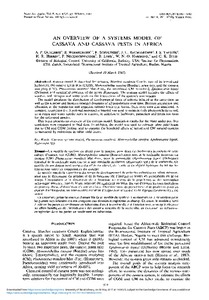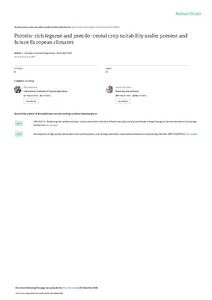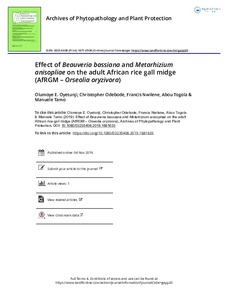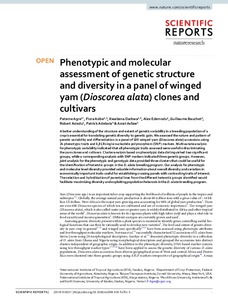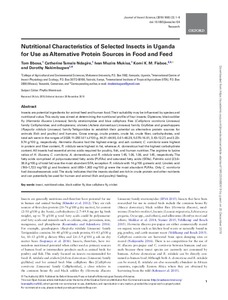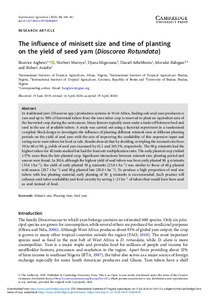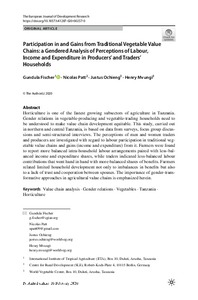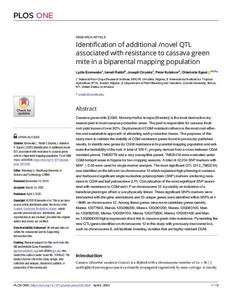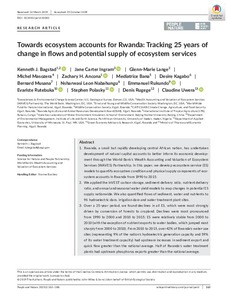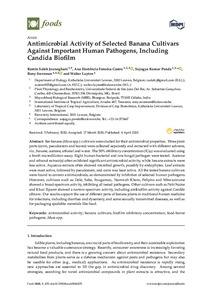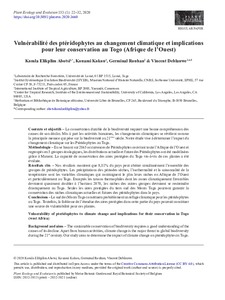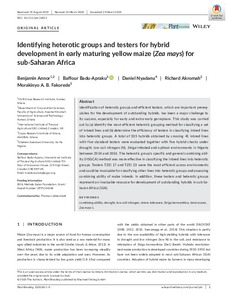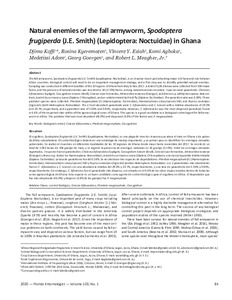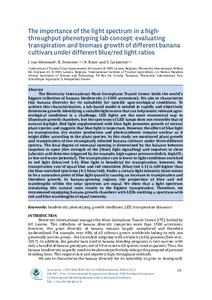Welcome to the International Institute of Tropical Agriculture Research Repository
Journal and Journal Articles: Recent submissions
Now showing items 1221-1240 of 5271
-
An overview of a systems model of cassava and cassava pests in Africa
(1987)A systems model is described for cassava, Manihot esculenta Crantz, two of its introduced herbivores, the cassava green mite (CGM), Mononychellus tanajoa (Bondar), sensu lato, and the cassava mealybug (CM), Phenacoccus manihoti Mat.-Ferr., the introduced CM parasitoid, Epidinocarsis lopezi (DeSantis) and coccinellid predator of the genus Hyperaspis. The systems model includes the effects of weather, soil nitrogen and water levels on the interactions of the system’s components. The model simulates ... -
Using a participatory approach and legume integration to increase the productivity of early maturing maize in the Nigerian Sudan Savannas
(2019)Drought, infestation of cereal crops by the parasitic weed Striga hermonthica, and poor soil fertility are the major constraints to maize production by smallholder farmers in the Sudan savannas of northern Nigeria. Four innovation platforms (IPs) were therefore established in 2008 in the Sudan savanna (SS) agroecological zone of northern Nigeria to create a stakeholder forum to address these identified food production challenges in the target areas. The IPs comprised researchers from Bayero ... -
Review of empirical and emerging breeding methods and tools for yam (Dioscorea spp.) improvement: status and prospects
(2020-06)Yam (Dioscorea spp.) is an important tuber crop with tremendous potential as a functional food in the tropics and subtropics. However, the crop has not shown progressive productivity gain over decades due to various production constraints. This paper reviews the progress achieved in empirical breeding endeavours and the development, status and application of emerging breeding tools and technologies to translate genetic gains in yam improvement. Significant progress has been made in yam genetic ... -
Protein-rich legume and pseudo-cereal crop suitability under present and future European climates
(2020)Replacing animal proteins with plant proteins in diets has been demonstrated to have both health and environmental advantages, driving a debate about the potential of protein-rich crops as dietary replacements for animal products. However, there is a lack of knowledge on how climate change could influence the potential for producing protein-rich crops. This study addresses this knowledge gap for the European Union. We analysed 13 protein-rich crops, using the crop suitability model EcoCrop and ... -
Effect of Beauveria bassiana and Metarhizium anisopliae on the adult African rice gall midge (AfRGM – Orseolia oryzivora)
(2019)Rice is an important staple crop whose production is limited by array of insect pests and diseases. African rice gall midge (AfRGM) Orseolia oryzivora Harris & Gagné (Diptera: Cecidomyiidae) is a major insect pest of lowland rice ecology in Africa. Heavy yield losses have been recorded in many farmers’ rice fields. Use of synthetic insecticides has fostered environmental and human health concern that initiates a search for alternative control measures such as Entomopathogenic fungi (EPF) – Beauveria ... -
Phenotypic and molecular assessment of genetic structure and diversity in a panel of winged yam (Dioscorea alata) clones and cultivars
(2019)A better understanding of the structure and extent of genetic variability in a breeding population of a crop is essential for translating genetic diversity to genetic gain. We assessed the nature and pattern of genetic variability and differentiation in a panel of 100 winged-yam (Dioscorea alata) accessions using 24 phenotypic traits and 6,918 single nucleotide polymorphism (SNP) markers. Multivariate analysis for phenotypic variability indicated that all phenotypic traits assessed were useful in ... -
Nutritional characteristics of selected insects in Uganda for use as alternative protein sources in food and feed
(2019)Insects are potential ingredients for animal feed and human food. Their suitability may be influenced by species and nutritional value. This study was aimed at determining the nutritional profile of four insects: Dipterans; black soldier fly (Hermetia illucens Linnaeus) family stratiomyidae and blue calliphora flies (Calliphora vomitoria Linnaeus) family Calliphoridae; and orthopterans; crickets (Acheta domesticus Linnaeus) family Gryllidae and grasshoppers (Ruspolia nitidula Linnaeus) family ... -
The influence of minisett size and time of planting on the yield of seed yam (Dioscorea Rotundata)
(2020-05-22)In traditional yam (Dioscorea spp.) production systems in West Africa, finding sole seed yam producers is rare and up to 30% of harvested tubers from the ware tuber crop is reserved to plant an equivalent area of the harvested crop during the next season. Many farmers typically must make a trade-off between food and seed in the use of available tubers. A study was carried out using a factorial experiment in a randomised complete block design to investigate the influence of planting different ... -
Participation in and gains from traditional vegetable value chains: a gendered analysis of perceptions of labour, income and expenditure in producers' and traders' households
(2020-02-26)Horticulture is one of the fastest growing subsectors of agriculture in Tanzania. Gender relations in vegetable-producing and vegetable-trading households need to be understood to make value chain development equitable. This study, carried out in northern and central Tanzania, is based on data from surveys, focus group discussions and semi-structured interviews. The perceptions of men and women traders and producers are investigated with regard to labour participation in traditional vegetable value ... -
Identification of additional/novel QTL associated with resistance to cassava green mite in a biparental mapping population
(2020-04-02)Cassava green mite [CGM, Mononychellus tanajoa (Bondar)] is the most destructive dry-season pest in most cassava production areas. The pest is responsible for cassava fresh root yield losses of over 80%. Deployment of CGM resistant cultivars is the most cost-effective and sustainable approach of alleviating such production losses. The purposes of this study were to validate the stability of CGM resistance genes found in previously published results, to identify new genes for CGM resistance in ... -
Towards ecosystem accounts for Rwanda: tracking 25 years of change in flows and potential supply of ecosystem services
(2019-12-09)Rwanda, a small but rapidly developing central African nation, has undertaken development of natural capital accounts to better inform its economic development through the World Bank's Wealth Accounting and Valuation of Ecosystem Services (WAVES) Partnership. In this paper, we develop ecosystem service (ES) models to quantify ecosystem condition and physical supply components of ecosystem accounts in Rwanda from 1990 to 2015. We applied the InVEST carbon storage, sediment delivery ratio, nutrient ... -
Interactions between the female parasitoid Epidinocarsis lopezi De Santis (Hym., Encyrtidae) and its host, the cassava mealybug, Phenacoccus manihoti Matile-Ferrero (Hom., Pseudococcidae)
(1988-12)In laboratory experiments, the influence of different host instars and population densities of the cassava mealybug (CM), Phenacoccus manihoti Matile‐Ferrero, on the reproductive performance of the encyrtid parasitoid Epidinocarsis lopezi (De Santis), was investigated. In choice experiments, fourth instar hosts were examined most frequently, but third instar hosts were stung most often. Stinging was followed by oviposition in 87.7% of all third instar CM, and 57.1% of all second instars. At constant ... -
Screening preemergence herbicides for weed control in cassava
(2020-02-17)Weed competition severely constrains cassava root yield in sub-Saharan Africa; thus, good weed control measures, including the use of herbicides, are increasingly important. Herbicide trials were conducted at five locations across eastern, western, and north-central Nigeria over two cropping seasons (2014 and 2015). Nineteen premixed PRE herbicides applied at different rates were evaluated for efficacy on weeds and selectivity on cassava. Manual hoe-weeding at 4, 8, and 12 wk after planting (WAP) ... -
Antimicrobial activity of selected banana cultivars against important human pathogens, including candida biofilm
(2020-04-04)Ten banana (Musa spp.) cultivars were studied for their antimicrobial properties. Three plant parts (corm, pseudostem and leaves) were collected separately and extracted with different solvents, viz., hexane, acetone, ethanol and water. The 50% inhibitory concentration (IC50) was evaluated using a broth microdilution assay. Eight human bacterial and one fungal pathogen were tested. Acetone and ethanol extract(s) often exhibited significant antimicrobial activity, while hexane extracts were less ... -
Vulnérabilité des ptéridophytes au changement climatique et implications pour leur conservation au Togo (Afrique de l’Ouest)
(2020-03-26)Contexte et objectifs – La conservation durable de la biodiversité requiert une bonne compréhension des causes de son déclin. Mis à part les activités humaines, les changements climatiques se révèlent comme la principale menace qui pèse sur la biodiversité au 21ème siècle. Notre étude vise à déterminer l’impact du changement climatique sur les Ptéridophytes au Togo. Méthodologie – En se basant sur 2865 occurrences de Ptéridophytes couvrant toute l’Afrique de l’Ouest et regroupés en 5 groupes ... -
Identifying heterotic groups and testers for hybrid development in early maturing yellow maize (Zea mays) for sub-Saharan Africa
(2020-04-20)Identification of heterotic groups and efficient testers, which are important prerequisites for the development of outstanding hybrids, has been a major challenge to its success, especially for early and extra‐early germplasm. This study was carried out to (a) identify the most efficient heterotic grouping method for classifying a set of inbred lines and (b) determine the efficiency of testers in classifying inbred lines into heterotic groups. A total of 205 hybrids obtained by crossing 41 inbred ... -
Gender and impact of climate change adaptation on soybean farmers' revenue in rural Togo, west Africa
(2020-04-01)This study assesses the impact of climate change (CC) adaptation on farm-level revenue among 500 soybean farmers randomly selected in three districts in Togo using endogenous switching regression method. The survey results indicate that only 40.37% of the women have adapted to CC against 59.62% of the men. Moreover, being member of farmer-based organization (FBO), access to credit and extension services, agricultural training of women are the main factors that increase the likelihood of adaptation. ... -
Distribution, prevalence, and severity of damages caused by nematodes on yam (Dioscorea Rotundata) in Nigeria
(2020-04-17)Nigeria is the main yam-growing country of the world. In the country, various plant-parasitic nematodes have been reported constraining yam production and the storability of tubers. This study established the damage level of nematodes on white yam tubers (Dioscorea rotundata) across the major production areas in the country for management purposes. Incidence and severity of symptoms (cracking, dry rot, and galling) associated with nematodes were assessed on 1,114 yam heaps (181 vendors) from 23 ... -
Natural enemies of the fall armyworm, Spodoptera frugiperda (J.E. Smith) (Lepidoptera: Noctuidae) in Ghana
(2020-04-08)The fall armyworm, Spodoptera frugiperda (J.E. Smith) (Lepidoptera: Noctuidae), is an invasive insect pest attacking maize in Ghana and sub-Saharan Africa countries. Biological control will need to be an important management strategy, and a first step was to identify potential natural enemies. Sampling was conducted in different localities of the 10 regions of Ghana from May to Nov 2017. A total of 1,062 larvae were collected from 106 maize farms, and the presence of natural enemies was recorded ... -
The importance of the light spectrum in a high-throughput phenotyping lab concept: evaluating transpiration and biomass growth of different banana cultivars under different blue/red light ratios
(2020-03)The Bioversity International Musa Germplasm Transit Center holds the world's biggest collection of banana biodiversity (>1500 accessions). We aim to characterize this banana diversity for its suitability for specific agro-ecological conditions. To achieve this characterization, a lab-based model is needed to rapidly and objectively determine growth. Identifying a suitable light source that can help mimic relevant agro-ecological conditions is a challenge. LED lights are the most economical way to ...

